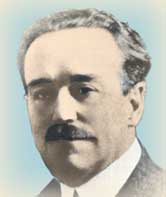
How will you spend New Year's day? Perhaps you will watch a football bowl game or write a list of resolutions for the coming year. On this day, January 1, 1901, Agnes Ozman did neither. She spoke an unknown language for the first time in her life.
You could say it was Charles Parham's doing. Parham was convinced that if the church was to meet the challenges of the twentieth century, an outpouring of the Holy Spirit was needed. He expressed his views through a bimonthly paper called Apostolic Faith. Believing that divine healing was possible, he founded the Bethel Healing Home in Topeka where those who were sick could gather to unite in prayer for healing. Around 1900, he left Topeka expressly to hear for himself what the best-known holiness preachers of the day had to say--men such A. B. Simpson, Alexander Dowie, and Frank Standford. On his brief tour, Parham encountered students who spoke in tongues.
Back in Topeka, he founded Bethel Bible School. It opened in October 1900 in a rambling house known as "Stone's Folly," because its previous owner had not been able to complete it. Among the forty students who gathered under Parham's teaching was Agnes Ozman.
Agnes' parents had homesteaded a Nebraska farm in 1871, the year after she was born in Wisconsin. The six Ozman children were reared in the Methodist Episcopal Church. As a young woman, Agnes attended various Bible institutes and participated in home mission work in Kansas City. She decided to give Bethel Bible a try.
Parham led his students through a study of the major tenets of the holiness movement, including sanctification and divine healing. Baptism by the Holy Spirit is spoken of in the New Testament and Parham wondered, what was its evidence? He asked his students to examine the issue over a period of three days, while he had to be away, and see what they thought.
Upon his return, he found the students unanimously agreed that speaking with other tongues was the proof that the Holy Spirit had fallen upon an individual. Four times in the book of Acts the Spirit is recording as falling on people. Each time, they spoke in tongues.
The students of Bethel Bible School and their mentor planned a New Year's eve "watch night" service to pray for the Holy Spirit. After midnight, on the first day of 1901, Agnes asked Parham to lay his hands on her and pray specifically that she might be filled with the Holy Spirit and speak in another tongue as evidence of the filling. According to the others, his prayer was heard. Agnes began speaking in Chinese. Those with her reported that a halo seemed to surround her head and face. Soon afterward, the remaining students also spoke in unknown languages and later Parham himself did too. It is said that Agnes could not speak English for three days and was only able to write in Chinese characters.
Coming as a direct result of prayer, her experience convinced the other students that tongues should accompany filling by the Holy Spirit. Many Christian theologians disagree, but Agnes' New Year's morning experience was a red letter day in the modern "Pentecostal" movement.
Bethel Bible folded that same Spring. Agnes left to work as a city missionary in Omaha. In 1911, she married Pentecostal evangelist, Philemon LaBerge. They worked with struggling congregations. The Pentecostal movement gained prominence when it spread to California, and burst upon the nation through the Asuza Street Revival that began in April, 1906.
Agnes died in California in 1937, leaving behind her an unusual and notable legacy.
Bibliography:
- Armitage, Thomas. A History of the Baptists; traced by their principles and practices, from the time of our Lord and Saviour Jesus Christ to the present. New York: Bryan, Taylor and co., 1893. Source of the image.
- Dictionary of American Religious Biography. Westport, Connecticut : Greenwood Press, c1977.
- Synan, Vinson. The Holiness-Pentecostal Tradition. Grand Rapids, Michigan: W.B. Eerdmans Pub. Co., 1997.